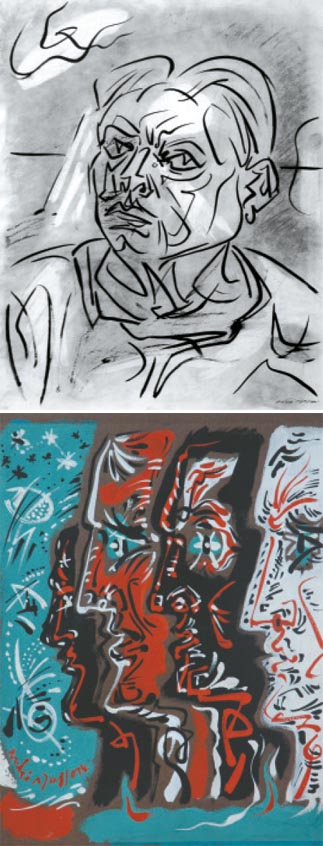Automatist works that moved a generation

Top: “Self-portrait” (1944) by Andre Masson, ink and charcoal on paper
Above: “Profile” (1965) by Andre Masson, gouache on paper. Provided by the gallery
The first exhibition of Masson’s work in Korea, which starts tomorrow at Die Galerie in southern Seoul, aims to help the public become more familiar with this French artist, who also influenced Jackson Pollock, a well-known U.S. painter. The event also celebrates the gallery’s first anniversary.
“Masson began to try automatic drawings to get images to arise from the unconscious even before Andre Breton announced the Surrealist Manifesto of 1924,” said Kim Ha-lin, curator of Die Galerie.
Breton, a French writer and the leader of the Surrealist movement, defined surrealism as “pure psychic automatism.”
“After looking at Masson’s works, Breton proposed that he join the Surrealist movement,” Kim said.
Masson later left the movement, however, because he did not completely agree with the movement’s platform and became dissatisfied with the leadership of Breton, who tended to force the artists in the movement to follow the platform, according to a statement from the gallery.
Masson went on his way, experimenting as he went along. In one series of paintings from the 1920s, he would apply glue to parts of a canvas and then threw sand at it, filling the other parts of the canvas with oil paint or brushing away the excess sand. Some of the paintings he made in this style in the 1950s are in this exhibit.
When the Nazis occupied France during World War II, Masson fled to the United States, where he created works with strong colors. He returned to France only after the war ended.
His works influenced many American abstract expressionists. One of the artists on whom he made the greatest impression was Pollock, who is famous for his action paintings, in which he drips or sprinkles paint on the canvas.
The majority of the Die Galerie exhibit consists of works Masson created in the 1950s and ’60s. Some of them, made with isolated brushstrokes surrounded by blank space, seem reminiscent of East Asian calligraphy.
And in fact, Masson was said to have been inspired by East Asian calligraphy and Zen Buddhism, the gallery’s statement read.
*The exhibition runs until March 25. Hours are Tuesday through Saturday from 10 a.m. to 7 p.m. and Sundays from 10 a.m. to 6 p.m. Admission is free. For more information, visit www.die-galerie.co.kr or call (02) 3447-0048-9.
By Moon So-young [symoon@joongang.co.kr]










with the Korea JoongAng Daily
To write comments, please log in to one of the accounts.
Standards Board Policy (0/250자)